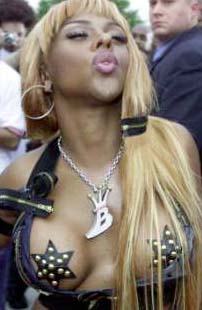 Is hip-hop dead? It sure sounds like it if you turn on the radio. What used to be exciting, groundbreaking music seems to have been reduced to a one-note din. The only topics discussed are bling-bling materialism, how many guns you have, and "ho's." Hip-hop poster boy 50 Cent appears on the cover of Rolling Stone with the caption "Mastering The Art of Violence." There's the raunchy Lil' Kim, and of course, top dog and now Oscar-winner Eminem, who has threatened to kill his wife numerous times on his records.
Is hip-hop dead? It sure sounds like it if you turn on the radio. What used to be exciting, groundbreaking music seems to have been reduced to a one-note din. The only topics discussed are bling-bling materialism, how many guns you have, and "ho's." Hip-hop poster boy 50 Cent appears on the cover of Rolling Stone with the caption "Mastering The Art of Violence." There's the raunchy Lil' Kim, and of course, top dog and now Oscar-winner Eminem, who has threatened to kill his wife numerous times on his records. Back in hip-hop's heyday of the '80s and early '90s, some of the most popular groups were also some of the most vibrant - the militant Public Enemy, the uplifting Arrested Development, the stylistically abstract A Tribe Called Quest, and the teacher KRS-One. Despite different approaches, they seemed to be working together to speak about the black experience and create the melting pot that made hip-hop so refreshing and vital.
"In the late '80s, there was such a diversity (in hip-hop)," says Kevin Powell, former Vibe magazine senior writer and editor of "Who Shot Ya? Three Decades of Hip-Hop Photography." "If you were a young black male growing up then, you could aspire to be Chuck D, or Big Daddy Kane, or Too Short, or Doug E. Fresh. You had choices. That doesn't exist anymore."
It's certainly harder to find. And offering it may take courage. When everyone else is talking about violence and riches, it's tough to talk about more cerebral issues without being laughed at by your peers and being called soft. "It is more difficult to try and make the masses buy it," says Common, one of hip-hop's most positive thinkers. He and Talib Kweli, performing at Roseland tomorrow evening, headline one of the most socially conscious hip-hop tours of the year.
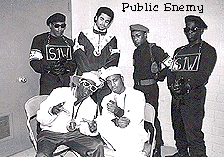 One of the pioneers of politically conscious rap, Public Enemy co-creator Bill Stephney, feels that the music has gone so far from its roots that it is almost a parody at this point. "There is an over-representation of the criminal aspects of black youth culture (in music) from the videos and the records," he says. "Not all black kids out here are slinging cocaine, crack and heroin, and shooting at one another. What about the black kid who works at Haagen-Dazs in Brooklyn? He or she is not represented. What about the black kid who just goes to church with his grandmother on Sunday? I don't hear their story in any of these records! All I hear is bang, bang, shoot 'em up." Star, the outspoken host of Hot 97's morning show who never shies from calling hypocrisy when he sees it, calls this "die niggas, die slowly," and Stephney agrees.
One of the pioneers of politically conscious rap, Public Enemy co-creator Bill Stephney, feels that the music has gone so far from its roots that it is almost a parody at this point. "There is an over-representation of the criminal aspects of black youth culture (in music) from the videos and the records," he says. "Not all black kids out here are slinging cocaine, crack and heroin, and shooting at one another. What about the black kid who works at Haagen-Dazs in Brooklyn? He or she is not represented. What about the black kid who just goes to church with his grandmother on Sunday? I don't hear their story in any of these records! All I hear is bang, bang, shoot 'em up." Star, the outspoken host of Hot 97's morning show who never shies from calling hypocrisy when he sees it, calls this "die niggas, die slowly," and Stephney agrees. So what happened? How did rap devolve from its glorious past to what even some founders suggest is its least innovative period? One of the reasons for the nihilistic themes that dominate today's rap music, Stephney believes, can be traced directly to the rise of the crack epidemic in urban communities.
"The heavy influence of the crack trade changed many of the values of the youth black culture since the mid-'80s," Stephney says. "That's where you get the materialism, the guns, the absolute die-hard mentality for meaningless things. So if you add all those things to the history of black people in general, then you get a very bad mix."
This mentality started reflecting itself in the music in the early '90s with the introduction of the group NWA. Their albums explicitly detailed a hard-core lifestyle of violence, drugs and sex, and when sales exploded - to both black and white teenagers - the themes in rap songs started to turn decidedly darker.
Politically aware groups like Public Enemy and Digable Planets were pushed aside as records labels, hungry to match the enormous sales of NWA and always eager to exploit the next big thing, looked for groups that replicated the winning formula. After the mega-success of Suge Knight's Death Row Records - which released albums by Dr. Dre and Snoop Dogg - hip-hop's new direction was firmly set.
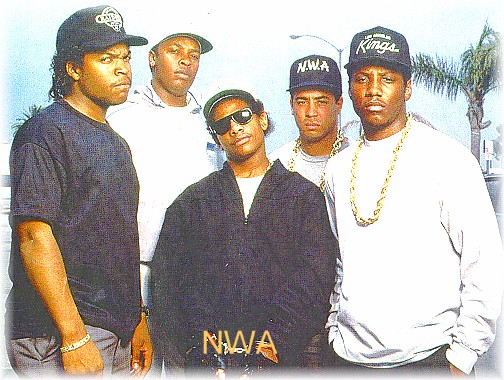 "I think that NWA's first album was brilliant," says Powell. "However, with their second album, 'Niggaz4Life,' they just created an album for shock value - and they didn't care." Albums like "Niggaz4Life" and Dr. Dre's "The Chronic," he says, became "the blueprint for what have seen in hip-hop for the last 10 years."
"I think that NWA's first album was brilliant," says Powell. "However, with their second album, 'Niggaz4Life,' they just created an album for shock value - and they didn't care." Albums like "Niggaz4Life" and Dr. Dre's "The Chronic," he says, became "the blueprint for what have seen in hip-hop for the last 10 years." At the same time these negative images started dominating the music, hip-hop became big business and received mainstream exposure.
"No one knew that hip-hop would not only become a mainstream sort of pop music, but the mainstream youth pop music," Stephney says. "The most popular artist of the past five years has been a white rapper, Eminem. Not a solo singer, not Mick Jagger. It's been a rapper."
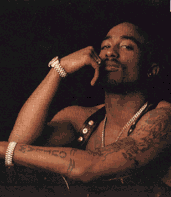 Eminem's first three albums, with total sales of 20 million, represents $300 million gross for Interscope Records, if you figure $15 a CD. Tupac Shakur's two best-selling albums alone ("All Eyez On Me" and his greatest hits at 9 million each) made $270 million for Death Row/Interscope, using that same formula. And the three best-selling albums of Notorious B.I.G. made $240 million for Bad Boy/BMG.
Eminem's first three albums, with total sales of 20 million, represents $300 million gross for Interscope Records, if you figure $15 a CD. Tupac Shakur's two best-selling albums alone ("All Eyez On Me" and his greatest hits at 9 million each) made $270 million for Death Row/Interscope, using that same formula. And the three best-selling albums of Notorious B.I.G. made $240 million for Bad Boy/BMG. Giant record companies have made huge profits selling ghetto culture to the American mainstream. "The drug trade is dominating the ghettos," Stephney says. "Then you have corporate America that makes a ton of money off of the culture that dominates within the ghettos. This is unprecedented. To me, that's the dominant reason why the music is the way it is.
"When you have large corporations who do not have the time to cultivate and build anything new in the ways that Berry Gordy did 40 years ago, they're just going to get the easiest thing, the lowest common denominator."
But the problems go deeper than the labels. The artists also share the blame for not daring to be different. Puff Daddy, for example, who while making ground-breaking records with Ma$e and B.I.G., more recently topped the charts with songs that didn't so much use samples as borrow entire records.
"If you have a million-dollar budget, you're not trying to lose that and go back to the 'hood because you're trying to create something. You're trying to keep it going and ride with it," says Doug E. Fresh, whose seminal anthem "The Show" with Slick Rick helped change hip-hop. "Artists want to get paid so badly that they are (reluctant) to push the bar a little bit. Hip-hop has always been a music that took chances; that's what made it different than all other music. (The music) is suffering because artists aren't taking chances anymore."
Another reason for the shift in hip-hop is that the consumers have changed, says Stephney. "When black sales were a large portion of rap sales, who were the big (rap) groups? Whodini ("One Love"), Run-DMC, Slick Rick. It wasn't the stuff that we hear now. The rap records that are sold (now) are usually sold in chains in the suburbs. They're sold to white kids in the suburbs that are looking for something more rebellious; they're not trying to hear any love songs!"
So, as his partner Chuck D says, "The bottom line dictates their business (and) the people that run black music have liquidated a marketable criminal element to sell to the world. Thus 15 years ago, rappers rapped for the people, whereas today they rap and rep for their companies, because the money dictates the direction."
Despite these problems with the music, there are some rappers who are bucking the trend and are being courageous enough to talk about more diverse themes, including Common, The Roots, Talib Kweli, Mos Def and Dead Prez.
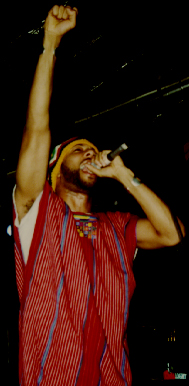 Common is coming off of his fifth album, the eclectic "Electric Circus," with its hit single "Come Close," a tender love song to girlfriend Erykah Badu that featured the vocals of Mary J. Blige. He has grown tremendously from his first album, 1992's "Can I Borrow A Dollar," where he posed for the album cover with a 40-ounce in a brown paper bag. His hip-hop classic, "I Used To Love H.E.R.," a song that protested the proliferation of gangster rap and was the inspiration for the film "Brown Sugar," put him on the map, and marked the beginning of a journey of maturation.
Common is coming off of his fifth album, the eclectic "Electric Circus," with its hit single "Come Close," a tender love song to girlfriend Erykah Badu that featured the vocals of Mary J. Blige. He has grown tremendously from his first album, 1992's "Can I Borrow A Dollar," where he posed for the album cover with a 40-ounce in a brown paper bag. His hip-hop classic, "I Used To Love H.E.R.," a song that protested the proliferation of gangster rap and was the inspiration for the film "Brown Sugar," put him on the map, and marked the beginning of a journey of maturation. "When you look at the state that (rap) is in, it's very corporate and that's what takes away a lot of the purity of it," says Common. "But I think it's starting to change as people such as myself, The Roots, Talib Kweli and Mos Def are getting more exposure (and) balancing out some of the other hip-hop that lacks the love for the art and the effort of innovation."
Common believes that there are many innovative hip-hop artists out there that just need an opportunity to be heard. "We have to understand that the best stuff is going to be in the underground," he says. "There are people doing independent records right now that are putting out good music, (but) not getting exposure."
Bill Stephney agrees. "Even with PE, the desire wasn't to be conscious per se; the idea was to make great records," he says. "We had a specific political concept, but the overriding thing was to make fantastic music. That's all it is at the end of the day."
No comments:
Post a Comment